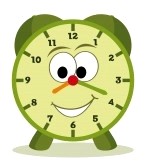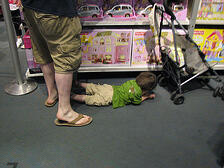7 Ways to Avoid Meltdowns
Just the thought of your children throwing a fit in public can cause you to have a meltdown. Relax, mamas, it’s normal for kids to have meltdowns, they’re part of growing up. However, even though meltdowns are normal, don’t let them become the norm. If children are allowed to throw fits, without your disapproval and consequence, they will learn to use that negative behavior to get their way. You are the boss. Here are my 7 ways to avoid meltdowns.
1. Proper sleep
When children don’t get their sleep, they are cranky. Heck, when I don’t get my sleep I’m cranky. According to doctors, children need at least 12 to 14 hours sleep a day. Bedtime should be between 7  and 9. I personally think 7:30 is a great bedtime, because it gives moms and dads some time together. When children have healthy sleeping habits they’re happier when they are awake.
and 9. I personally think 7:30 is a great bedtime, because it gives moms and dads some time together. When children have healthy sleeping habits they’re happier when they are awake.
2. Watch your time
Always avoid taking your kids out during the arsenic hour. It’s that time in the early to mid-evening when your babies and young children can go from their previously placid, contented selves to crying and unhappy at the flick of some evil switch.
Timing is everything with children. Always consider their needs  first. It’s not fair to take them to a restaurant or shopping at nap time or late at night and expect them to behave.
first. It’s not fair to take them to a restaurant or shopping at nap time or late at night and expect them to behave.
3. Food and water
Always make sure your children are hydrated and not hungry when you head to the mall or to visit a friend. If you’re going to be  out for an extended period of time bring water and sugarless snacks. I really believe sugar is a real brat maker. If you want to give sweet snacks, give berries. Note: cereal when metabolized is mainly sugar including the sugar that’s mixed in with the grains (just look on the box).
out for an extended period of time bring water and sugarless snacks. I really believe sugar is a real brat maker. If you want to give sweet snacks, give berries. Note: cereal when metabolized is mainly sugar including the sugar that’s mixed in with the grains (just look on the box).
While on a cruise, I did some serious family watching and I noticed the ill-behaved children (they stick out) acted up in the buffet lines suggesting they were hungry and needed to have eaten earlier.
4. Avoid useless directives
I also noticed on that cruise, parents using useless directives on the not so well behaved.
One day we were in line for lunch behind Jason (about six-years-old), his sister Becky (about four-years-old) and their parents. In the course of five minutes, I watched Jason hit his sister, tug and hang on his father’s shirt, kick his mother’s purse and sag to the floor several times.
“Jason, what’s rule number seven?”
Hmmm, I wondered what it could be. Was it, Don’t hit your sister? Don’t kick mommy? Don’t hang off daddy’s shirt? Or was it don’t throw yourself on the floor whining?
My guess is that the mom read in some Parenting for Parents Who Don’t Have Time to Parent Guide, to avoid saying anything negative to your child, like “Don’t hang off daddy’s shirt,” and instead number the don’ts and refer to the number of the don’t, rather than the don’t. (I remember reading in a child psychology book, “…when you say to a child, “don’t kick, he doesn’t hear the word don’t and just hears the word kick.”) That might be the case with a two-year-old, but certainly not a six-year-old.
Whatever rule # seven was, Jason obviously hadn’t practiced it enough to use it while waiting in line. At  the age of six, he would have minded it if it had been enforced. But it takes consistency at home to teach your children what you expect and how you expect them to behave. Rule # seven is not going to work in public if it’s not enforced at home. The House Fairy can help too. In the Manners and Good Behavior program, the House Fairy tells her Snuggle Bunnies all the basics of good behavior and manners,
the age of six, he would have minded it if it had been enforced. But it takes consistency at home to teach your children what you expect and how you expect them to behave. Rule # seven is not going to work in public if it’s not enforced at home. The House Fairy can help too. In the Manners and Good Behavior program, the House Fairy tells her Snuggle Bunnies all the basics of good behavior and manners,
5. Tricks will backfire in the long run
Jason ignored his mom’s attempt at remembering rule # seven, so when the kicking, whining, and hitting failed to get more attention, he began to cry. The crying prompted the mother to pull out another tip from some psychologist’s (probably one who never had kids) list of suggestions. “Jason, don’t you laugh! Do you hear me? DO NOT LAUGH!” That made him mad, so he socked his sister again and she started crying. The mother ignored Jason’s violence and tried the same command on the sobbing girl: “Becky, don’t you laugh!”
By daring a child not to laugh, even in a playful way, is really teaching a child to go against what it is you want. I wonder how that psychology would work when Jason and Becky are teenagers. “Hey, kids, do not  have sex on your dates tonight.”
have sex on your dates tonight.”
Jason pulled every trick out of his Be-A-Brat-Bag as we queued our way through the buffet. I felt sorry for the parents and the kids. Jason should have been removed by one of the parents and either taken back to the stateroom, or taken to a table with a hunk of turkey.
6. Meltdowns make great teaching tools
Whenever you are out in public and you see a child in meltdown, use the drama of the out of control child to teach your children what not to do. You can say something like, “Oh dear, look at that! I’m so proud of the way you behave. You never beg for things when we go to the store! If you acted that way, we’d be out of here so fast and, and I would not take you to the movies like we planned.” When you paint a penalty picture,  your children can put themselves in the hypothetical situation and it will cause them to feel good about behaving.
your children can put themselves in the hypothetical situation and it will cause them to feel good about behaving.
7. When it’s too late
When it’s too late to avoid a meltdown, remove the child from the situation even if it causes you to change all of your plans. When children understand that you are the  boss, they learn quickly. Be flexible with your plans when training your children to behave. The punishment for a meltdown is to go back home.
boss, they learn quickly. Be flexible with your plans when training your children to behave. The punishment for a meltdown is to go back home.



